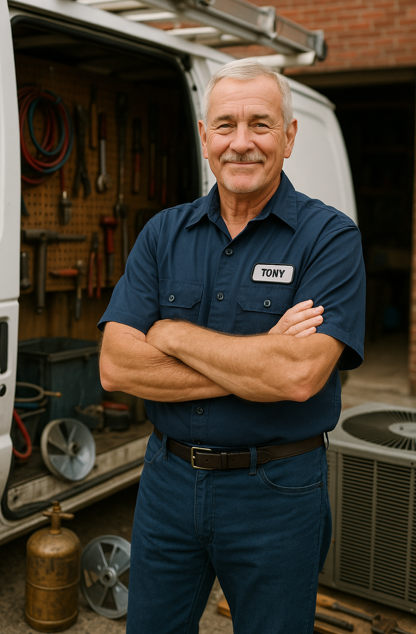👋 Hey there, Tony Marino here.
If you’re shopping for an 80,000 BTU gas furnace — or any furnace that pairs with air conditioning — you may have heard the term R-32 refrigerant popping up lately. You’re probably wondering: What is R-32? Why is it showing up in gas furnace discussions? And most importantly, what do I as a homeowner need to know?
This guide is for homeowners who want straightforward, practical info. We’ll cover:
-
What R-32 refrigerant actually is
-
Why the HVAC industry is switching to R-32
-
How R-32 fits into gas furnace systems paired with AC or heat pumps
-
Safety and handling concerns
-
Maintenance tips
-
How R-32 affects your energy bills and environmental footprint
And, of course, how all this ties into choosing the right furnace for your home.
If you want to check out specific R-32 gas furnace models, you can visit the pillar page here: R-32 Gas Furnaces – 80,000 BTUs.
❄️ What Is R-32 Refrigerant?
R-32 is a next-generation refrigerant officially known as Difluoromethane. It’s a single-component refrigerant used in many modern air conditioners and heat pumps.
Compared to older refrigerants like R-410A, R-32 offers:
-
Lower Global Warming Potential (GWP): Around 675 vs. 2,088 for R-410A, which means it’s significantly better for the environment.
-
Higher energy efficiency: It transfers heat more effectively, meaning systems using R-32 can be smaller and use less electricity.
-
Simpler composition: Being single-component makes it easier to recycle and handle.
The HVAC industry has increasingly adopted R-32 because it aligns with global efforts to reduce greenhouse gas emissions. If you want a detailed, technical overview, check out ASHRAE’s R-32 profile.
🔥 How Does R-32 Relate to Gas Furnaces?
Here’s the common misconception: Gas furnaces themselves don’t use refrigerants. They burn fuel to generate heat. But in many modern homes, your heating system isn’t just a furnace — it’s part of a hybrid heating and cooling system.
That means your gas furnace is paired with:
-
A central air conditioner, or
-
A heat pump that uses refrigerant to move heat in or out of your home
If your AC or heat pump uses R-32, your furnace needs to be compatible with that refrigerant for optimal performance and safety.
⚙️ Why You Want a Matched R-32 System
Buying an 80,000 BTU gas furnace designed for R-32 paired systems isn’t just a marketing gimmick — it ensures:
-
Better system efficiency: Matched systems have components designed to work in sync.
-
Warranty protection: Manufacturers require matched components to honor warranties.
-
Simplified servicing: Technicians trained on R-32 will maintain your system properly.
-
Lower environmental impact: Using R-32 refrigerant aligns with regulations and future-proofs your HVAC setup.
Want to see how efficiency benefits stack up? ENERGY STAR provides clear criteria for furnaces designed for matched systems.
🛡️ Safety: What Homeowners Should Know About R-32
R-32 is classified as an A2L refrigerant — mildly flammable with low toxicity. That might sound scary at first, but here’s what you should know:
-
The amount of R-32 used in residential HVAC systems is carefully regulated and limited.
-
Proper installation and servicing ensure safe operation.
-
Manufacturers design equipment with safety features to contain refrigerant safely.
-
Only certified HVAC technicians should handle R-32.
If you want a deep dive into safety, Intertek’s overview on R-32 refrigerant safety is a trusted resource.
🔧 Maintenance Tips for R-32 Systems
Maintaining an R-32 hybrid HVAC system is similar to other setups but with a few key points:
-
Schedule annual professional inspections, especially focusing on refrigerant charge and leak detection.
-
Use certified technicians trained on R-32 to service the system.
-
Keep the outdoor unit clean and free from debris to maximize heat exchange efficiency.
-
Monitor your energy bills for spikes that could indicate a problem.
Routine care ensures your system runs efficiently and safely, extending its life and saving money.
🌍 Environmental Benefits of R-32
Switching to R-32 helps reduce your carbon footprint because:
-
R-32 has a much lower GWP than older refrigerants, meaning less impact on global warming.
-
Systems using R-32 are generally more energy efficient, which lowers electricity consumption.
-
Many countries and states now require or incentivize R-32 use to meet environmental standards.
To understand how these regulations affect you, check out the EPA’s info on approved refrigerants under the SNAP program.
💸 What Does R-32 Mean for Your Energy Bills?
Better efficiency means:
-
Potentially lower monthly electricity costs, especially if your AC or heat pump runs often.
-
A higher upfront cost for equipment balanced by savings over time.
-
Eligibility for rebates or tax credits for upgrading to R-32 systems.
Use tools like the Energy.gov Appliance and Equipment Standards to estimate savings from high-efficiency HVAC upgrades.
✅ What to Look for When Buying an R-32-Compatible Gas Furnace
-
Compatibility: Confirm your furnace is designed for R-32 paired systems.
-
Efficiency: Look for at least 90% AFUE for the furnace and ENERGY STAR certification.
-
Blower type: ECM or variable-speed motors improve efficiency and comfort.
-
Installation: Hire HVAC contractors certified to handle R-32 safely.
-
Warranty: Ensure manufacturer warranties cover R-32 applications.
🏡 Final Thoughts From Tony Marino
R-32 refrigerant represents the future of HVAC—more efficient, more environmentally responsible, and designed to deliver better comfort for homeowners like you.
While gas furnaces don’t use refrigerants themselves, making sure your furnace is compatible with an R-32 air conditioner or heat pump is critical to system longevity and performance.
If you want a reliable, efficient 80,000 BTU gas furnace that’s ready to work with R-32 systems, check out the lineup at The Furnace Outlet’s R-32 Gas Furnace Collection.
Invest smart, install right, and you’ll enjoy warm winters and cool summers with peace of mind.







